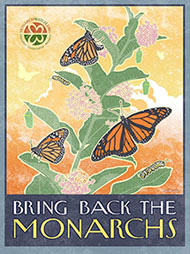Ascending – growing upward at an angle from a somewhat horizontal base.
Clasping – leaf grows directly off the stem and appears to be grasping the stem.
Corolla – all five petals of a milkweed flower. When these pedals open, they expose the hoods.
Elliptic – a descriptor of shape. Width is shorter compared to the length with both base and apex somewhat pointed.
Fusiform – a descriptor of shape of roots. Narrower at both ends than in the middle.
Glabrous – hairless.
Glaucous – bluish to whitish green. Often used to describe juvenile leaves with a waxy bloom or small fine hairs.
Herbaceous – not woody, soft stemmed.
Hoods – five cup-like flower structures of many milkweeds that hold nectar.
Horns – delicate spikes of floral tissue that frequently protrude from hoods on milkweed flowers.
Inflorescence – a cluster of flowers on a stem.
Pedicels – stem of a flower that is part of an umbel.
Peduncle – the stem supporting an umbel.
Petiole – stem of a leaf.
Petiolate –when a leaf is attached to a stem by a petiole.
Pollinia – sacks of pollen (2) – the saddle bags – that are part of the pollinarium, an elaborate structure that attaches to the legs of pollinators to affect pollination in milkweeds.
Ramet – a stem arising from a rhizome forming part of a clone
Rhizome – root system that spreads horizontally often giving rise to new, and genetically identical, stems (ramets) thus forming clones.
Sessile – a descriptor of leaf attachment. The leaf is directly attached to the stem.
Taproot – root system that grows vertically downward.
Tinge – tint, color present.
Umbel – type of inflorescence that has a few to >100 pedicels bearing flowers that spread from a single point or base.




